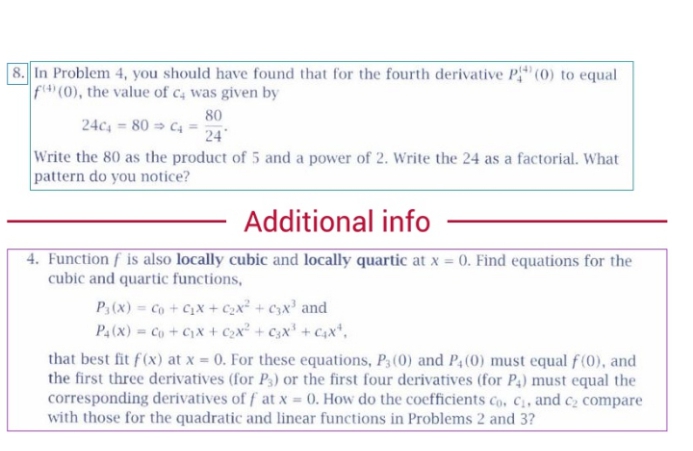80 24c 80 C = 24 Write the 80 as the product of 5 and a power of 2. Write the 24 as a factorial. What pattern do you notice?
80 24c 80 C = 24 Write the 80 as the product of 5 and a power of 2. Write the 24 as a factorial. What pattern do you notice?
College Algebra
7th Edition
ISBN:9781305115545
Author:James Stewart, Lothar Redlin, Saleem Watson
Publisher:James Stewart, Lothar Redlin, Saleem Watson
Chapter2: Functions
Section: Chapter Questions
Problem 30P: In this problem you are asked to find a function that models in real life situation and then use the...
Related questions
Question
Please solve it step by step with complete description and details,as I am weaker in mathematics.

Transcribed Image Text:8. In Problem 4, you should have found that for the fourth derivative P" (0) to equal
f (0), the value of c4 was given by
80
24c, = 80 > C4 =
24
Write the 80 as the product of 5 and a power of 2. Write the 24 as a factorial. What
pattern do you notice?
Additional info
4. Function f is also locally cubic and locally quartic at x = 0. Find equations for the
cubic and quartic functions,
P3(x) = Co + Cx + C2x² + C3x' and
P, (x) Co + Cx + Cx² + C3x' + Cx*,
that best fit f(x) at x = 0. For these equations, P3 (0) and P,(0) must equal f(0), and
the first three derivatives (for P3) or the first four derivatives (for P4) must equal the
corresponding derivatives of f at x = 0. How do the coefficients co, C, and c2 compare
with those for the quadratic and linear functions in Problems 2 and 3?
Expert Solution
This question has been solved!
Explore an expertly crafted, step-by-step solution for a thorough understanding of key concepts.
This is a popular solution!
Trending now
This is a popular solution!
Step by step
Solved in 2 steps

Recommended textbooks for you

College Algebra
Algebra
ISBN:
9781305115545
Author:
James Stewart, Lothar Redlin, Saleem Watson
Publisher:
Cengage Learning

Functions and Change: A Modeling Approach to Coll…
Algebra
ISBN:
9781337111348
Author:
Bruce Crauder, Benny Evans, Alan Noell
Publisher:
Cengage Learning

Algebra & Trigonometry with Analytic Geometry
Algebra
ISBN:
9781133382119
Author:
Swokowski
Publisher:
Cengage

College Algebra
Algebra
ISBN:
9781305115545
Author:
James Stewart, Lothar Redlin, Saleem Watson
Publisher:
Cengage Learning

Functions and Change: A Modeling Approach to Coll…
Algebra
ISBN:
9781337111348
Author:
Bruce Crauder, Benny Evans, Alan Noell
Publisher:
Cengage Learning

Algebra & Trigonometry with Analytic Geometry
Algebra
ISBN:
9781133382119
Author:
Swokowski
Publisher:
Cengage